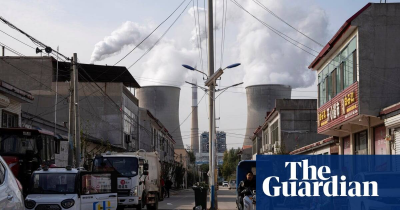The Guardian-Growth in CO2 emissions leaves China likely to miss climate targets
February 22, 2024 5 min 899 words
这篇报道揭示了中国在实现2025年气候目标方面的困境。尽管清洁能源成为经济增长的主要推动力,但大部分能源增长仍来自燃煤电厂,导致碳排放继续上升。报道指出,中国政府在发展可再生能源的同时,继续批准燃煤电厂,导致2023年能源需求增长超过GDP增长,碳排放增长速度远高于2016-2020年。分析认为,中国在2025年气候目标方面偏离轨道,尤其是碳强度的增长。文章强调了政府在疫情期间通过刺激建筑和制造业来支持经济的做法,使得经济增长的模式更加碳密集。此外,虽然可再生能源装机容量增加,但能源需求的迅速增长仍然使得实现目标面临巨大挑战。文章最后提到,中国在2023年批准的燃煤电厂容量远超过清洁能源,表明一些地方政府为了提高地方GDP仍依赖于煤矿和燃煤电源的投资。这需要中国在2024-2025年采取果断行动,以避免未能实现气候承诺。
China is off track on all of its core 2025 climate targets, despite the fact that clean energy is now the biggest driver of the country’s economic growth, analysis has found.
After years of extraordinarily rapid growth, China is now grappling with a slowdown that is causing ripples internally and internationally. The government has supercharged the growth of the renewable energy industry but it has imultaneously poured stimulus funds into construction and manufacturing, and continues to approve coal power.
China’s total energy consumption increased by 5.7% in 2023, in the first moment since 2005 that demand for energy grew faster than its GDP. China’s economy grew by 5.2% last year, a rate that would be rapid for most countries but is slow in comparison with previous rates of growth.
But carbon dioxide emissions have continued to grow, even as economic growth has slowed due to the fact that China’s economic growth during and after the Covid-19 pandemic has been highly energy intensive. Between 2021 and 2023, CO2 emissions grew at an average of 3.8% a year, up from 0.9% a year between 2016 and 2020. GDP growth slowed slightly over the same period.
The findings were published in an analysis from Carbon Brief conducted by Lauri Myllyvirta, a lead analyst at the Centre for Research on Energy and Clean Air (CREA).
Under the Paris agreement, China’s climate pledges require a number of targets to be met by 2025; these include increasing the share of non-fossil energy sources to 20% and reducing the carbon intensity of the economy by 18%. Carbon intensity refers to how many grams of CO2 are released to produce a kilowatt hour of electricity.
However, Myllyvirta’s analysis found that China was “way off track” on many of these targets, primarily because of the carbon intensity of recent economic growth. CO2 emissions will have to fall by between 4% and 6% to meet the government’s 2025 target, Myllyvirta predicts.
Part of the problem stems from the fact that during the Covid-19 pandemic, the government supported the economy by injecting stimulus measures into the construction and manufacturing sector, “shifting the pattern of growth into a more carbon-intensive direction”, said Myllyvirta. At the same time, many other countries targeted their stimulus measures towards households, driving up demand for consumer goods, resulting in an export boom from China.
It is not impossible to do, said Myllyvirta: “Optimistically, these distortions to the economic structure before and during zero-Covid could be reversed, and that combined with the clean energy drive could serve to bring down emissions rapidly.”
Around one percentage point of China’s CO2 emissions growth last year came from manufacturing clean energy technologies, such as solar PV, electric vehicles and batteries. These products will ultimately lead to a net drop in emissions, although some of that will be felt outside China as goods are exported.
Part of the challenge in understanding China’s energy transition is that the numbers involved in every sector are of global significance. Despite the fact that, in 2023, China commissioned as much solar PV as the entire world did in 2022, according to the International Energy Agency, the rapid growth in energy demand in recent years has outstripped the clean energy additions.
On the current trend of increased energy demands, energy production from non-fossil sources would need to grow by more than 11% a year to meet the 2025 target. Currently, renewable energy production is increasing by an annual rate of 8.5%. Clean energy contributed $1.6tn (£1.26tn) to China’s economy in 2023, accounting for all of the growth in investment.
And on the target of reducing the carbon intensity of China’s economy by 18% by 2025, China has so far managed only a 5% reduction since 2020. That means that CO2 emissions will have to come down in absolute terms from 2023 to 2025 to meet the target.
According to the National Energy Administration, China’s installed capacity of renewable energy exceeded 1.45bn kilowatts in 2023, accounting for more than half of the country’s total installed power generation capacity.
But a separate report published on Thursday by CREA found that China approved 114 gigawatts (GW) of coal power in 2023, up from 104 GW in 2022. China’s share of global coal emissions surpassed 64% in 2023.
Since Xi Jinping, China’s leader, pledged to “strictly control” new coal power in 2021, the approval of new coal has actually increased rapidly. Nearly half of the growth in power generation between 2020 and 2023 came from coal. That is partly because some thermal power developers and government officials see this decade as a window of opportunity in which CO2 emissions can continue to increase before 2030, when Xi has promised they will peak. Still, China is widely expected to meet that target by 2025.
Local governments, particularly mining provinces, often rely on investment in coalmines and thermal power sources to boost their GDP figures.
Myllyvirta said: “The major acceleration in coal consumption growth and in approvals of new coal power plants that has taken place since President Xi made these pledges in 2021 contradicts the commitments – and China needs to take determined action in 2024-25 to avoid failing to respect them.”

